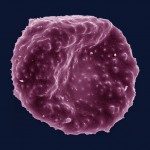Link to Pubmed [PMID] – 1783420
Immunology 1991 Dec;74(4):606-12
It has previously been demonstrated that a gene on chromosome 1 in or near Mls-1 controls, on the surface of B cells, the mobility and aggregability of major histocompatibility complex (MHC) class II molecules but not the mobility or aggregability of other B-cell molecules, such as immunoglobulin (Ig) and class I antigens. We report here that this gene may also influence the aggregability of two class II antigen-reactive molecules on the surface of T cells, the T-cell receptor complex and CD4. The aggregability of the two membrane components is markedly higher on Mls-1+ T cells than on Mls-1- T cells. The properties of this phenomenon were examined in vitro as well as in vivo with particular emphasis on CD4 aggregability. It was found that, after removal of B cells, T cells lose the ability to aggregate CD4 in our standard CD4 aggregation assay. Similarly, T cells isolated from the B-cell-deficient environment of the thymus failed to aggregate CD4. Addition of B cells to either thymic T cells or B-cell-depleted peripheral T cells established CD4 aggregability within minutes. This process can be blocked with antibody against CD4 or antibody against Ia. The Mls-1 genotype predicts within the limited tests of this study the efficacy of the B-cell ability to impose a CD4 aggregation pattern on T cells: Mls-1+ B cells are markedly more effective in this respect than Mls-1- B cells. This can be demonstrated in tissue culture as well as in the animal. Similar to the Mls-1 response, this is a one-way process: Mls-1+ B cells confer to Mls-1- mice a CD4 aggregation pattern typical of the Mls-1+ mouse while Mls-1- B cells do not impose a Mls-1b-typical CD4 aggregation pattern in Mls-1a mice. Mls-1+ B cells also influence the composition of lymphocytes in the mouse. Mls-1+ mice or Mls-1- mice treated with Mls-1+ B cells have fewer T cells and more B cells in their spleen than Mls-1- animals. The gene that encodes stimulatory Mls-1 cell-surface structures has recently been identified as an endogenous mammary tumour virus (Mtv-7). We expect that the analysis of the virus genome will produce information whether the effects described here can be attributed to the virus or not.

